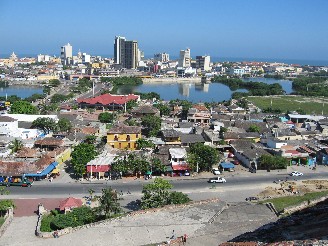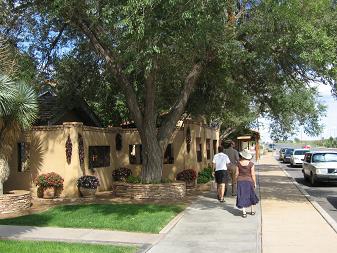Reunited
The climb out of Copper Canyon from Batopilas to Creel takes the morning, with a stop to refill the hydraulic reservoir for Katie's clutch. In the logging town of Creel I stop for lunch and again perform the oil refill ceremony. The leak is getting worse. For the last several days, as often as possible, I shift without the clutch but this is no way to treat Katie. Luckily there is a good KTM dealer in Chihuahua.
Chihuahua. Famous as the haunt of Mexican heroes Pancho Villa and Father Miguel Hidalgo, this lovely and modern city of 670,000 is set among rugged hills in a semi-arid desert. Francisco "Pancho" Villa, the mustachioed hero of the 1910-1920 revolutionary war, lived here for a time. The Museo Historico de la Revolucon features the bullet-riddled Dodge at whose wheel he met his end in Parral in 1923. Of the 100 bullets fired into the car, 12 found their mark in assassinating the popular hero of the people. At Plaza Hidalgo an eternal flame commemorates Independence hero Father Hidalgo - marking the spot where he was executed by firing squad in 1811 after leading a rebellion against the Spanish crown. Today I find clean, wide streets, ultra modern shopping centres and many USA chains - Wendys, MacDonalds, Chili's, Sears, Wall-Mart; I might as well be in Texas. The "culture shock" I feel at all this is a little unsettling. While Katie is repaired once more, this time by KTM dealer Equipo Extremo, I stay in a well appointed Microtel hotel, expensive by South America standards but half the cost of the U.S.A equivalent.
The ride on national and toll roads to the border crossing at Ojinaga, Chihuahua/Presidio, Texas is smooth and pleasant. Even at the typically expensive toll gates, the cost for Katie is only 33 pesos ($3.00), one third the cost of tolls elsewhere in Mexico. At Ojinaga I have one last scrumptious lunch and get a 50 peso hair cut with the last of my Mexican money. It is hot here at 38 Celsius and the town's appearance not as attractive as its neighbours to the south. At the Mexico Aduana, I pay $20 more for the privilege of leaving Mexico - where did that come from? Also leaving a small bad taste in my mouth, the Mexico customs at Ojinaga claims ignorance at returning my "security deposit" of 2000 pesos when I entered a month before from Guatemala. Finally there is a $2 toll charge to use the bridge over the Rio Grande into Texas. It is this aduana "death by a 1000 cuts" that make travelling in latin america less pleasant than necessary.
The greeting by U.S. customs officials is cordial and super efficient. The Presidio officers don't even want to see my passport and think it novel that I want to go into the customs building and get it stamped. It takes me longer to take my helmet off than to be served by the folks in the lovely air-conditioned office. The ride from Presidio to Alpine, Texas starts out hot but it isn't long before my afternoon companions, los nube negros, fill the horizon. The thermometer on Katie drops from 42C to 19C in just a few miles. I continue to ride towards the black, slanting streaks ahead, zipping up my jacket as I go. This Texas rain feels good and it is so nice to feel cool air again.
August 13, Sunday, 12:25 PM. As I watch from the shade of the terminal building, Cessna N3276S touches down at Alpine airport. Aboard is pilot and long time friend Ricky Rocket (better known to some as Rick Martsolf), his brother Steve (better known to some as US Naval Captain Martsolf, to others as Captain Stevie) and my wife, the beautiful Miss P (better known to some as Joyce). It is a joyful reunion and some tears are shed amidst the hugging and happy talk. Eight calendar months, 203 days, have passed since I said goodby to my life partner. It is good to be together again.
Rick has rented a car so after stowing our gear at the lovingly restored Holland Hotel in Alpine, we take a drive to Big Bend National Park. Rick's geology knowledge enhances our adventure as we explore among the 40 to 190 million year old formations. A flat tire does little to dampen our enthusiasm but it does work up a thirst in all of us as we watch Steve change the tire in the 104 F heat. We head off to the spic and span town of Marathon, Texas and home of the neatest restaurant/hotel I've ever seen, the Gage Hotel. Decorated in old southwest Texas fashion, the place is at once classy, down-home comfortable and a museum in its own right. The white albino buffalo mount in the lounge says it all. Laine, the manager, pulls priceless 18th and 19th century rifles off the restaurant walls for Steve and I to examine while we wait for our first cool ones. Some margueritas, beers, and wine are organized around an awesome supper, followed after sundown by coffee and dessert in the courtyard, with cognac and cigars, of course.
On the drive back from Marathon to Alpine under big Texas stars, we stop for an impromptu pee break. A flashlight contest breaks out. Luckily no sheriff comes along to witness the tom-foolery, as the explaining of four grow'd adults, somewhat impaired, would have to have been quite creative to keep from spending a night in the crowbar hotel.
Come morning, Rick and Steve fly back to Dallas in the Cessna 182 while Joyce joins me on Katie for my last leg to Dallas. The southern part of Texas becomes a blast furnace as we ride in the punishing 40 Celsius heat. At midnight in Del Rio it's still in the high 90s F.
A day later we arrive in San Antonio, doff our stuff in a hotel and escape some of the summer heat by touring their enchanting riverwalk. First founded with a presidio by the Spanish in 1716, the most famous event for most of us, when we think of San Antonio, was the american defence of the Alamo in 1836. However, a force far stronger than Santa Anna's Mexican Army was the constant flooding of the San Antonio River. When Mexico ceded Texas, California, New Mexico and most of Arizona to the United States for $18,250,000 in 1848, one of the first orders of business was again the defence of the city. A series of water control measures were enacted. The ones in 1926, including a bypass channel, led directly to the beautification projects that are the foundation of what Joyce and I see today. Massive trees overhang the walk and rio, providing much appreciated shade.
Paseo Del Rio, as the four kilometre walk is also called, showcases many of San Antonio's most spectacular hotels, restaurants, night clubs, bars, shopping centers and businesses. $800 million a year flows into the local economy as a result of capitalizing on what started out as flood control. We manage to leave our fair share of the 800 mil in our afternoon/evening there.

Our journey to Dallas takes all day as we ride for an hour in 105 F temperatures, seek shelter in an air-conditioned restaurants for an hour, then ride for another hour, and so on. The air is so hot I must do up my jacket and close my helmet visor completely. I almost feel like I am firefighting again. At 8 P.M. we arrive at Rick and Paulette's home in north Dallas.
For me, rejoining Joyce and arriving in Dallas means the South America journey is unofficially over. Now it's just another holiday. I have safely travelled for nearly 50,000 kilometres; 23,122 kilometers on Katie, and along the way achieved a goal set at the start: to practise autopsis, the art of seeing for oneself. That I have.
Below are a couple of lists that summarize what happened financially and what I remember most.
MSC COSTS:
The average cost of travelling by Katie (2004 KTM 950 Adventure motorcycle) was US$51/day. It broke out this way: Fuel - 15%; Food - 22%; Accommodation - 25%; Motorcycle (repairs, airfreight, highway tolls, etc) - 17%; and Other (customs/taxes, taxis, gifts, tours, internet, etc) - 21%.

MY TOP 10 THINGS COMMON TO LATIN AMERICA (in no particular order):
1. WILLINGNESS TO HELP/FRIENDLY/APPROACHABLE: This ranks as hands-down Number One commonality. Latinos, whether South, Central or North American, are people-oriented. No matter where I went I felt welcome.
2. LIMES: the little green buggers are served with everything from celery to cerveza. They taste best in my Platypus (three litre water backpack).
3. CELL PHONES: From high in the remote Los Andes de Peru to downtown Chihuahua. Everybody has one even if they have little else.
4. NOISE: Everywhere. Music, TV, barking dogs, traffic, and folks talking - gregarious, friendly and without apology. What I rarely heard were angry words - or aircraft flying overhead.
5. FAMILY: the unit bonds together from abuela to youngest chica (something we in North American have allowed to slip in priority). Young families are the largest segment of the population, with a significant percentage of children under ten.
6. CATHOLIC RELIGION: with every town having a catholic church, many of which are hundreds of years old, the dominant faith of latin america is still very much in practise.
7. POLLUTION: especially in the ditch on the roads out of town - seems be the substitute for the town dump. Mostly plastic: drinking bottles, containers and bags. And truck tires. Some countries were much cleaner than others.
8. NIGHT LIFE: In keeping with the emphasis on family and socialization, the evenings are THE time to see family, friends and lovers in the local town plaza de armas or zocalo.
9. ROAD SIGNS: Almost completely absent in towns and cities (how does anyone find their way?), the distance/destination/highway number signs are sparingly displayed on highways, yet by strange contradiction, every bridge is faithfully named. A road map with bridge names would be more useful than conventional maps.
10. BEAUTIFUL SCENERY: No matter which country I visited there was always much to be in awe of, much justification for national pride. South America continues to be, in my estimation, a best kept secret.
This is the last chapter of my blog. My dear friends and family, thank you all for your kind support. Your words of encouragement have been as comforting as if you had been a companion with me on the journey.
Buen viaje, mis amigos. Hasta pronto.







